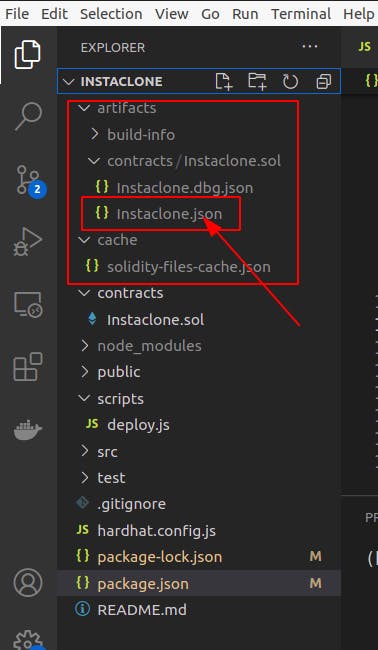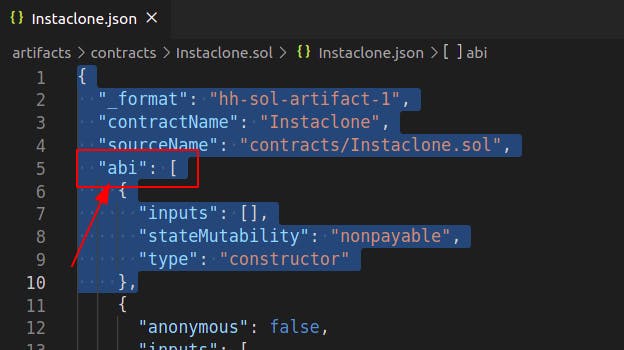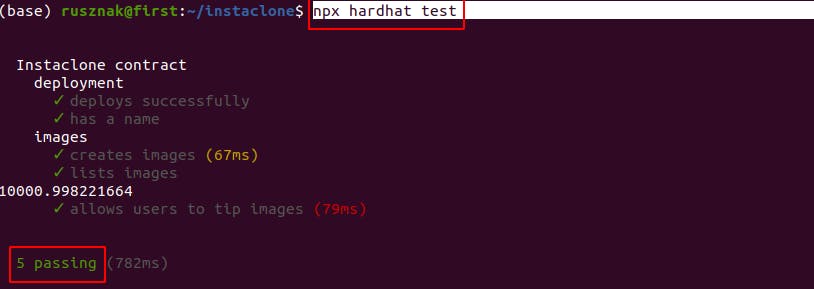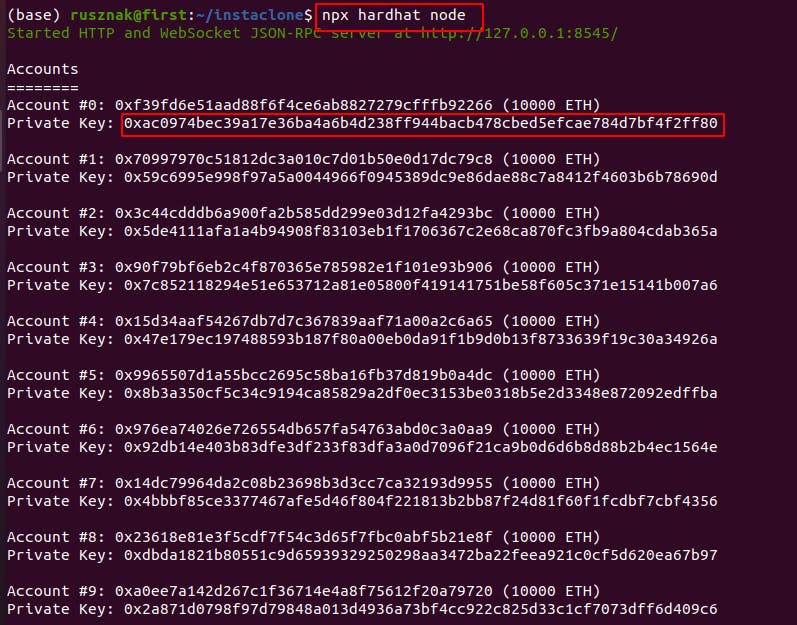Decentralized, censorship-resistant Instagram-clone Tutorial (Ethereum, Hardhat, Ethers.js, IPFS, React )
The Big Picture
We are at the tipping point of a new phase in the web’s evolution. I believe that the recent de-platforming of some prominent persons will just excelerate the progress. The old, centralized way where data is mostly stored in centralized repositories will give way to something new: Web 3.0. Decentralization is just one pillar of Web 3.0 (along with AI and other things) but it is where my focus currently lies. In this tutorial I show you how to make a fully decentralized, IPFS - backed Instagram-clone, where users can upload and tip images. I took my inspiration from dappuniversity.com but my code below is everything but a simple copy-paste:
- Dapp University uses truffle and ganache to compile and deploy. I use Hardhat and the built-in Hardhat Network that I found more convenient. Its functionality focuses around Solidity debugging, featuring stack traces,
console.log()and explicit error messages when transactions fail. - He used the Web3.js library to interact with the deployed contract and I used Ethers.js instead. This is a major difference as these two libraries are vastly different. I am not yet qualified to say which one is better but Ethers.js is smaller and newer so it is definitely something we should have an eye on.
- I also had to modify the way how he connects to IPFS (which did not work for me) but it is probably due to some problems with my versioning which I could not figure out.
- Instead of class-based React I used the newer, function based version.
The full code is available on Github.
Software versions:
- OS: Ubuntu 20.04.2 LTS
- node: v14.15.4
- npm: 6.14.10
Installing dependencies
As usual, execute the following command: npx create-react-app instaclone to create React frontend application with the name of instaclone. We'll use Hardhat to compile and deploy our contract, so install into your project folder, (i.e. instaclone):
npm install --save-dev hardhat
We also need some other dependecies:
npm install --save-dev @nomiclabs/hardhat-waffle ethereum-waffle chai @nomiclabs/hardhat-ethers
and also:
npm install ethers bootstrap identicon.js ipfs-api
When all the installation is done create your Hardhat project by running: npx hardhat.
Select Create an empty hardhat.config.js with your keyboard and hit enter. When Hardhat is run, it searches for the closest hardhat.config.js file starting from the current working directory. This file normally lives in the root of your project and an empty hardhat.config.js is enough for Hardhat to work. The entirety of your setup is contained in this file.
Replace the 'hardhat.config.js` file content with the following:
require("@nomiclabs/hardhat-waffle");
/**
* @type import('hardhat/config').HardhatUserConfig
*/
module.exports = {
solidity: "0.7.3",
};
Creating the Smart Contracts
Start by creating a new directory called contracts and create a file inside the directory called Instaclone.sol. The language for smart contracts is solidity.
I believe that anyone with some javascript or maybe java knowledge can decipher the meaning of a simple contract. I am not saying that solidity is java or javascript but I do say that if you have some years of javascript experience the transition to solidity should not be super bumpy.
The file's content should be the following:
pragma solidity ^0.7.0;
contract Instaclone {
string public name;
uint256 public imageCount = 0;
mapping(uint256 => Image) public images;
struct Image {
uint256 id;
string hash;
string description;
uint256 tipAmount;
address payable author;
}
event ImageCreated(
uint256 id,
string hash,
string description,
uint256 tipAmount,
address payable author
);
event ImageTipped(
uint256 id,
string hash,
string description,
uint256 tipAmount,
address payable author
);
constructor() public {
name = "Instaclone";
}
function uploadImage(string memory _imgHash, string memory _description)
public
{
// Make sure the image hash exists
require(bytes(_imgHash).length > 0, "Must have HASH");
// Make sure image description exists
require(bytes(_description).length > 0, "Must have DESCRIPTION");
// Make sure uploader address exists
require(msg.sender != address(0), "Must have AUTHOR");
// Increment image id
imageCount++;
// Add Image to the contract
images[imageCount] = Image(
imageCount,
_imgHash,
_description,
0,
msg.sender
);
// Trigger an event
emit ImageCreated(imageCount, _imgHash, _description, 0, msg.sender);
}
function tipImageOwner(uint256 _id) public payable {
// Make sure the id is valid
require(_id > 0 && _id <= imageCount, "NOT EXISTING IMAGE");
// Fetch the image
Image memory _image = images[_id];
// Fetch the author
address payable _author = _image.author;
// Pay the author by sending them Ether
payable(address(_author)).transfer(msg.value);
// Increment the tip amount
_image.tipAmount = _image.tipAmount + msg.value;
// Update the image
images[_id] = _image;
// Trigger an event
emit ImageTipped(
_id,
_image.hash,
_image.description,
_image.tipAmount,
_author
);
}
}
The contract has two interesting functions. The first one is uploadImage() Its name speaks for itself. However we won't upload the image itself to the smart contract, as it would be extremely expensive.
To store 1GB of data inside a smart contract on the Ethereum network would cost millions of dollars.
That's why we (the frontend) will upload the image to IPFS because IPFS returns a hash that uniquely identifies the uploaded image. Then we (frontend) can call the smart contract and upload and store only this hash. The uploadImage() function takes the IPFS-hash plus a string as description. The function validates that the uploaded data actually contains a hash and description (that's the job of the lines starting withrequire) and store the data in a struct which is similar to javascript objects. There is a class level variable called imageCount reflecting the number of uploaded images. We need to increment this variable. Finally the function emits an event to notify the calling frontend.
The second function is tipImageOwner(). It takes an argument which is the id of the image in question. It gets the relevant image from the struct which also contains the image's author's address. It is important to note that this function should be called only in a way that also sends some ether. We can get the exact amount of ether by msg.value (just like msg.sender reveals the caller's address). This amount then will be deducted from the caller's account and added to the author's account.
Finally the updates the struct and emits an event.
Compiling
Compilation is simple. Just run npx hardhat compile. The process creates a Json file based on the contract.

We need an ABI and an address to interact with any smart contract. This Json file contains the ABI.
 That's why I will copy it to the
That's why I will copy it to the src folder.
Testing the smart contract
Writing tests when building smart contracts is of crucial importance, as your user's money is what's at stake. Smart contracts are immutable, there is no way to modify them, we can only redeploy them. But that costs money. In this case we're going to use Hardhat Network, a local Ethereum network designed for development that is built-in and the default network in Hardhat. No need to setup anything to use it. In our tests we're going to use ethers.js to interact with the Ethereum contract we built.
Create a new directory called test inside our project root directory and create a new file called InstacloneTest.js. The content is the following:
const { expect } = require("chai");
describe('Instaclone contract', () => {
let InstacloneContract
let instaclone
let owner
let author
let tipper
before(async () => {
InstacloneContract = await ethers.getContractFactory("Instaclone");
[owner, author, tipper, ...addrs] = await ethers.getSigners();
instaclone = await InstacloneContract.deploy();
})
describe('deployment', async () => {
it('deploys successfully', async () => {
const address = await instaclone.address
expect(address).not.to.equal(0x0);
expect(address).not.to.equal('');
expect(address).not.to.equal(null);
expect(address).not.to.equal(undefined);
})
it('has a name', async () => {
const name = await instaclone.name()
expect(name).to.equal("Instaclone");
})
})
describe('images', async () => {
let result, imageCount, ev, args
const hash = 'QmZGQA92ri1jfzSu61JRaNQXYg1bLuM7p8YT83DzFA2KLH'
before(async () => {
result = await instaclone.connect(author).uploadImage(hash, 'Image description')
ev = await result.wait()
args = ev.events[0].args
imageCount = await instaclone.imageCount()
})
//check event
it('creates images', async () => {
// SUCESS
expect(imageCount.toNumber()).to.equal(1);
expect(args.id.toNumber()).to.equal(imageCount.toNumber(), "id is correct");
expect(args.hash).to.equal(hash, "hash OK");
expect(args.description).to.equal('Image description', "Description OK");
expect(args.author).to.equal(author.address, 'author is correct')
// FAILURE: Image must have hash
await expect(
instaclone.connect(author).uploadImage('', 'Image description')
).to.be.revertedWith("Must have HASH");
// FAILURE: Image must have description
await expect(
instaclone.connect(author).uploadImage(hash, "")
).to.be.revertedWith("Must have DESCRIPTION");
})
//check from Struct
it('lists images', async () => {
const image = await instaclone.images(imageCount)
expect(image.id.toNumber()).to.equal(imageCount.toNumber(), "id OK");
expect(image.hash).to.equal(hash, 'Hash is correct')
expect(image.tipAmount).to.equal(0, 'Amount is correct')
expect(image.description).to.equal('Image description', 'description is correct')
expect(image.author).to.equal(author.address, 'author is correct')
})
it('allows users to tip images', async () => {
// Track the author balance before purchase
let oldAuthorBalance = await ethers.provider.getBalance(author.address);
let oldAuthorBalanceString = ethers.utils.formatEther(oldAuthorBalance)
let weiValue = ethers.utils.parseEther('1')
result = await instaclone.connect(tipper).tipImageOwner(imageCount, { value: weiValue });
ev = await result.wait()
args = ev.events[0].args
imageCount = await instaclone.imageCount()
expect(args.id.toNumber()).to.equal(imageCount.toNumber(), "id NEM OK");
expect(args.hash).to.equal(hash, 'Hash is correct')
expect(args.description).to.equal('Image description', 'Hash is correct')
expect(args.tipAmount).to.equal(weiValue, 'Tip amount is correct')
expect(args.author).to.equal(author.address, 'Tip amount is correct')
// Check that author received funds
let newAuthorBalance = await ethers.provider.getBalance(author.address);
let newAuthorBalanceString = ethers.utils.formatEther(newAuthorBalance)
console.log(newAuthorBalanceString)
let tip = ethers.utils.parseEther('1')
const expectedBalance = oldAuthorBalance.add(tip)
expect(newAuthorBalanceString).to.equal(ethers.utils.formatEther(expectedBalance), "Author account INCREASED")
// FAILURE: Tries to tip a image that does not exist
await expect(
instaclone.connect(tipper).tipImageOwner(9999, { value: weiValue })
).to.be.revertedWith("NOT EXISTING IMAGE");
})
})
})
Couple of thing here: it needs chai. Nested describes are OK.
This is how we deploy the contract and get the testing account with Ethers.js:
InstacloneContract = await ethers.getContractFactory("Instaclone");
[owner, author, tipper, ...addrs] = await ethers.getSigners();
instaclone = await InstacloneContract.deploy();
This is how we call a function without sending money:
result = await instaclone.connect(author).uploadImage(hash, 'Image description')
ev = await result.wait()
args = ev.events[0].args
...
expect(args.description).to.equal('Image description', "Description OK");
If we do want to send money (Remember msg.value in the contract) we need to do like this:
let weiValue = ethers.utils.parseEther('1')
result = await instaclone.connect(tipper).tipImageOwner(imageCount, { value: weiValue });
ev = await result.wait()
args = ev.events[0].args
...
expect(args.tipAmount).to.equal(weiValue, 'Tip amount is correct')
We can also test for failure (Remember require in the contract):
await expect(
instaclone.connect(tipper).tipImageOwner(9999, { value: weiValue })
).to.be.revertedWith("NOT EXISTING IMAGE");
Run npx hardhat test and expect similar results:

Deployment
Create a file scripts/deploy.js with the following content:
async function main() {
const [deployer] = await ethers.getSigners();
console.log(
"Deploying contracts with the account:",
deployer.address
);
console.log("Account balance:", (await deployer.getBalance()).toString());
const Instaclone = await ethers.getContractFactory("Instaclone");
const clone = await Instaclone.deploy();
console.log("Instaclone Contract address:", clone.address);
}
main()
.then(() => process.exit(0))
.catch(error => {
console.error(error);
process.exit(1);
});
Open a new terminal and start Hardhat Network npx hardhat node. This gives you the available accounts.

Import the first account's private key to Metamask. The Network Settings should be as below:

Open another terminal and deploy the contract:
npx hardhat run --network localhost scripts/deploy.js
The result logs the address of the owner of the contract (deployer's address), the owner's balance and the contract address.
 Mark the contract's address because we'll need it later.
Mark the contract's address because we'll need it later.
Creating Frontend
The frontend consists two function-based React.js component, App.js and Renderer.js.
In App.js there is a useEffect hook which starts the cycle. It runs only once when the component gets created.
useEffect(() => {
const load = async () => {
await connectBlockChain();
}
load();
}, []);
UseEffect calls connectBlockchain() which, well connects to the smart contract. Note, this is the place where we need to specify the contract's address. (There might be a more elegant way to do it...)
const connectBlockChain = async () => {
....
await window.ethereum.enable();
const provider = new ethers.providers.Web3Provider(window.ethereum);
const signer = provider.getSigner();
const contract_address = "0x5FbDB2315678afecb367f032d93F642f64180aa3" //local
let deployedContract = new ethers.Contract(contract_address, Instaclone.abi, signer)
....
}
As I mentioned earlier we upload the file to IPFS which returns a hash. We upload this hash to our smart contract. This is implemented as follows:
const uploadImage = async (description) => {
//adding file to the IPFS
ipfs.files.add(buffer, async (error, result) => {
...here comes logging
//uploading hash to blockchain
const tx = await contract.uploadImage(result[0].hash, description);
const receipt = await tx.wait();
})
}
We send ether to the smart contract like this:
const tipImageOwner = async (id, tipAmount) => {
const tx = await contract.tipImageOwner(id, { value: tipAmount })
const receipt = await tx.wait();
}
Below is the full App.js file.
import React, { useEffect, useState } from 'react';
import Renderer from './Renderer.js';
import Instaclone from "./Instaclone.json"
const ipfsAPI = require('ipfs-api')
const ipfs = ipfsAPI('ipfs.infura.io', '5001', { protocol: 'https' })
const ethers = require('ethers');
function App() {
const [contract, setContract] = useState();
const [buffer, setBuffer] = useState();
const [images, setImages] = useState([])
const [loading, setLoading] = useState(false);
const connectBlockChain = async () => {
setLoading(true)
await window.ethereum.enable();
const provider = new ethers.providers.Web3Provider(window.ethereum);
const signer = provider.getSigner();
const contract_address = "0x5FbDB2315678afecb367f032d93F642f64180aa3" //local
let deployedContract = new ethers.Contract(contract_address, Instaclone.abi, signer)
setContract(deployedContract);
await fetchImgages(deployedContract);
setLoading(false)
}
// Load images
const fetchImgages = async (contract) => {
const imagesCount = await contract.imageCount()
for (var i = 1; i <= imagesCount.toNumber(); i++) {
const image = await contract.images(i);
images.push(image);
}
images.sort((a, b) => b.tipAmount - a.tipAmount);
}
useEffect(() => {
const load = async () => {
await connectBlockChain();
}
load();
}, []);
const captureFile = event => {
event.preventDefault()
const file = event.target.files[0]
const reader = new window.FileReader()
reader.readAsArrayBuffer(file)
reader.onloadend = () => {
let buff = Buffer(reader.result)
setBuffer(buff);
}
}
const uploadImage = async (description) => {
//adding file to the IPFS
ipfs.files.add(buffer, async (error, result) => {
console.log('Ipfs result = ', result)
if (error) {
console.error(error)
return
}
//uploading hash to blockchain
const tx = await contract.uploadImage(result[0].hash, description);
console.log("tx = ", tx)
const receipt = await tx.wait();
console.log("receipt = ", receipt)
})
}
const tipImageOwner = async (id, tipAmount) => {
const tx = await contract.tipImageOwner(id, { value: tipAmount })
console.log("tx = ", tx)
const receipt = await tx.wait();
console.log("receipt = ", receipt)
}
return (
<div className="App">
{ loading
? <div id="loader" className="text-center mt-5"><p>Loading...</p></div>
: <Renderer
images={images}
captureFile={captureFile}
uploadImage={uploadImage}
tipImageOwner={tipImageOwner}
/>
}
</div>
);
}
export default App;
Rendering the page is the task of Renderer.js. It contains a form for file upload:
<form onSubmit={(event) => {
event.preventDefault()
const description = imageDescription.value
uploadImage(description, captureFile)
}} >
The form has access to the relevant functions (uploadImage, captureFile) in App.js. It has access to the images, too and renders them iterating through them one by one with the help of IPFS/ Infura:
{images.map((image, key) => {
....
<img src={`https://ipfs.infura.io/ipfs/${image.hash}`}
The conversion between human-readable amounts like 0.01 and Ethereum-like values with many zeros takes also place here. Human-readable to BigNumber:
let tipAmount = ethers.utils.parseEther('0.01')
and back:
ethers.utils.formatEther(image.tipAmount)
Below is the full code of Renderer.js
import React from 'react';
import Identicon from 'identicon.js';
const ethers = require('ethers');
const Renderer = ({ images, uploadImage, captureFile, tipImageOwner }) => {
let imageDescription = "";
return (
<div className="container-fluid mt-5">
<div className="row">
<div className="content mr-auto ml-auto">
<h2>Share Image</h2>
<form onSubmit={(event) => {
event.preventDefault()
const description = imageDescription.value
uploadImage(description, captureFile)
}} >
<input type='file' accept=".jpg, .jpeg, .png, .bmp, .gif" onChange={captureFile} />
<div className="form-group mr-sm-2">
<br></br>
<input
id="imageDescription"
type="text"
ref={(input) => { imageDescription = input }}
className="form-control"
placeholder="Image description..."
required />
</div>
<button type="submit" className="btn btn-primary btn-block btn-lg">Upload!</button>
</form>
<p> </p>
{images.map((image, key) => {
return (
<div className="card mb-4" key={key} >
<div className="card-header">
<img
className='mr-2'
width='30'
height='30'
src={`data:image/png;base64,${new Identicon(image.author, 30).toString()}`}
/>
<small className="text-muted">{image.author}</small>
</div>
<ul id="imageList" className="list-group list-group-flush">
<li className="list-group-item">
<p className="text-center"><img src={`https://ipfs.infura.io/ipfs/${image.hash}`} style={{ maxWidth: '420px' }} /></p>
<p>{image.description}</p>
</li>
<li key={key} className="list-group-item py-2">
<small className="float-left mt-1 text-muted">
TIPS: {ethers.utils.formatEther(image.tipAmount)} ETH
</small>
<button
className="btn btn-link btn-sm float-right pt-0"
name={image.id}
onClick={(event) => {
let tipAmount = ethers.utils.parseEther('0.01')
tipImageOwner(event.target.name, tipAmount)
}}
>
TIP 0.1 ETH
</button>
</li>
</ul>
</div>
)
})}
</div>
</div>
</div >
)
}
export default Renderer
That's it. Congratulation. You have reached the end.
